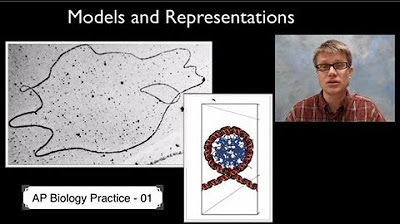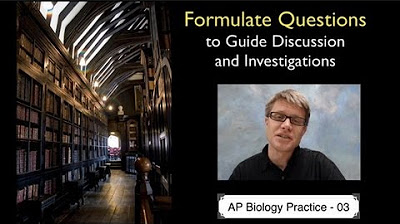AP Biology Practice 6 - Scientific Explanations and Theories
Summary
TLDRIn this AP Biology science practice, Mr. Andersen discusses the scientific method, emphasizing the development and refinement of theories through evidence-based experimentation. He explains natural selection, its evolution with sexual selection, and how theories like Mendelian genetics are refined over time. The video also covers the importance of applying theories to new data, such as in genetic inheritance and environmental influences on gene expression, preparing students to analyze and justify scientific claims.
Takeaways
- 🔬 The scientific method involves asking questions, gathering data, analyzing it, and developing theories to explain how the world works.
- 🐦 Natural selection, developed by Charles Darwin, is a mechanism that explains evolution, using the example of finches in the Galapagos adapting to different food supplies.
- 💡 Theories in science start with an idea, are tested through experiments, and are refined or replaced as new evidence emerges.
- 🔄 The process of theory development is cyclical, involving constant feedback to ensure theories align with observed phenomena in the universe.
- 🌏 Before natural selection, the belief was that species were perfectly placed on Earth by a divine power, which was challenged by scientific evidence.
- 🛠️ Theories are modified to accommodate new evidence, such as the incorporation of sexual selection into the theory of natural selection.
- 📚 Understanding and applying theories is crucial in various scientific fields, including evolution, genetics, and systems biology.
- 🧬 The environment can influence gene expression without changes to the DNA itself, involving mechanisms like histone modification.
- 📉 College Board encourages the application of theories to understand phenomena like antibiotic resistance, feedback loops in blood glucose regulation, and epigenetic changes.
- 📝 The ability to justify claims with evidence, construct explanations, and make predictions about natural phenomena is essential in scientific reasoning.
- 🧬 Mendel's laws of inheritance were foundational but have been refined over time to accommodate exceptions like autosomal linkage and sex-linkage.
Q & A
What is the process of developing a scientific theory according to the script?
-The process of developing a scientific theory involves coming up with a good question, gathering data, analyzing the data, and over time, developing theories that explain how the world works. If the evidence supports the idea, a theory is created to better understand the universe. The theory may be modified as new evidence is discovered to ensure it matches what's happening in the universe.
How does the script describe the concept of natural selection?
-Natural selection is described as a mechanism that explains how evolution can occur. It is illustrated with the example of finches on the Galapagos, which had variations in their beaks and adapted to their specific food supply over time.
What is the significance of the feedback loop in the context of scientific theories?
-The feedback loop is significant as it ensures that our theories match what is happening in the universe. It is a cycle of refining and improving theories based on new evidence and observations.
How did the understanding of species evolution change before the theory of natural selection?
-Before natural selection, the prevailing idea was that God had placed all species on the planet, perfectly evolved to where they are. This belief was challenged and eventually revolutionized by the theory of natural selection.
What are the four big ideas in which the College Board expects students to apply theories?
-The four big ideas are not explicitly listed in the script, but it can be inferred that they pertain to various aspects of biology such as evolution, genetics, regulation of biological processes, and the structure and function of biological systems.
How does antibiotic resistance in bacteria relate to the theory of natural selection?
-Antibiotic resistance in bacteria is an example of natural selection in action. Bacteria that have genetic variations allowing them to survive in the presence of antibiotics will thrive, while those without such variations will be eliminated, leading to a population of antibiotic-resistant bacteria.
What is the role of histones and methylation in gene expression as mentioned in the script?
-Histones and their methylation play a role in gene expression by controlling access to DNA. Methylation of histones can open up the chromatin structure, allowing for the expression of certain genes, which can be influenced by environmental factors.
What are the five ways the College Board wants students to deal with theories and explanations according to the script?
-The script does not list all five ways but mentions justifying claims with evidence, constructing explanations based on evidence, and making claims and predictions about natural phenomena. The other two ways are not explicitly stated in the provided transcript.
How does the script explain the refinement of Mendel's Laws in genetics?
-The script explains that Mendel's Laws, such as the law of segregation and independent assortment, were refined over time with the discovery of exceptions like autosomal linkage, sex-linkage, and polygenic inheritance, which do not follow straightforward Mendelian inheritance.
What is the example given in the script to illustrate the concept of genetic drift?
-The script uses the example of a bottleneck in the northern elephant seal population or cheetahs to illustrate genetic drift, which occurs when a population size decreases, leading to changes in the genetic make-up of the population.
How does the script relate the process of artificial selection to the theory of natural selection?
-The script relates artificial selection to natural selection by describing how humans can choose which individuals mate with whom, similar to how natural selection operates through environmental pressures and survival of the fittest.
What is the process described in the script for determining the genotypes of original parents in a genetic cross?
-The process involves analyzing the data given for the F1 and F2 generations, working backward to determine the inheritance pattern, and identifying whether the trait is sex-linked recessive or sex-linked dominant, as illustrated with the example of a wild type male and white-eyed female.
Outlines

このセクションは有料ユーザー限定です。 アクセスするには、アップグレードをお願いします。
今すぐアップグレードMindmap

このセクションは有料ユーザー限定です。 アクセスするには、アップグレードをお願いします。
今すぐアップグレードKeywords

このセクションは有料ユーザー限定です。 アクセスするには、アップグレードをお願いします。
今すぐアップグレードHighlights

このセクションは有料ユーザー限定です。 アクセスするには、アップグレードをお願いします。
今すぐアップグレードTranscripts

このセクションは有料ユーザー限定です。 アクセスするには、アップグレードをお願いします。
今すぐアップグレード関連動画をさらに表示

AP Biology Science Practice 1: Models and Representations

AP Biology Practice 7 - Connecting Knowledge

AP Biology Practice 3 - Formulate Questions

AP Biology Practice 4 - Data Collection Strategies

AP Biology Practice 2 - Using Mathematics Appropriately

AP Biology Practice 5 - Analyze Data and Evaluate Evidence
5.0 / 5 (0 votes)
